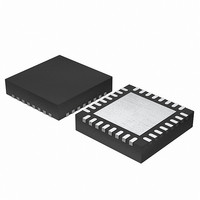EFM32G200F16 Energy Micro, EFM32G200F16 Datasheet - Page 186

EFM32G200F16
Manufacturer Part Number
EFM32G200F16
Description
MCU 32BIT 16KB FLASH 32-QFN
Manufacturer
Energy Micro
Series
Geckor
Datasheets
1.EFM32G200F16.pdf
(63 pages)
2.EFM32G200F16.pdf
(10 pages)
3.EFM32G200F16.pdf
(463 pages)
4.EFM32G200F16.pdf
(136 pages)
Specifications of EFM32G200F16
Core Processor
ARM® Cortex-M3™
Core Size
32-Bit
Speed
32MHz
Connectivity
EBI/EMI, I²C, IrDA, SmartCard, SPI, UART/USART
Peripherals
Brown-out Detect/Reset, DMA, POR, PWM, WDT
Number Of I /o
24
Program Memory Size
16KB (16K x 8)
Program Memory Type
FLASH
Ram Size
8K x 8
Voltage - Supply (vcc/vdd)
1.8 V ~ 3.8 V
Data Converters
A/D 4x12b, D/A 1x12b
Oscillator Type
External
Operating Temperature
-40°C ~ 85°C
Package / Case
32-VQFN Exposed Pad
Processor Series
EFM32G200
Core
ARM Cortex-M3
Data Bus Width
32 bit
Data Ram Size
8 KB
Interface Type
I2C, UART
Maximum Clock Frequency
32 MHz
Number Of Programmable I/os
24
Number Of Timers
2
Operating Supply Voltage
1.8 V to 3.8 V
Maximum Operating Temperature
+ 85 C
Mounting Style
SMD/SMT
Minimum Operating Temperature
- 40 C
Lead Free Status / RoHS Status
Lead free / RoHS Compliant
Eeprom Size
-
Lead Free Status / Rohs Status
Details
- EFM32G200F16 PDF datasheet
- EFM32G200F16 PDF datasheet #2
- EFM32G200F16 PDF datasheet #3
- EFM32G200F16 PDF datasheet #4
- Current page: 186 of 463
- Download datasheet (8Mb)
16.3.2.6.1 Single Data-link
16.3.2.6.2 Single Data-link with External Driver
2010-09-06 - d0001_Rev1.00
In this setup, the USART both receives and transmits data on the same pin. This is enabled by setting
LOOPBK in USARTn_CTRL, which connects the receiver to the transmitter output. Because they are
both connected to the same line, it is important that the USART transmitter does not drive the line when
receiving data, as this would corrupt the data on the line.
When communicating over a single data-link, the transmitter must thus be tristated whenever not
transmitting data. This is done by setting the command bit TXTRIEN in USARTn_CMD, which tristates
the transmitter. Before transmitting data, the command bit TXTRIDIS, also in USARTn_CMD, must be
set to enable transmitter output again. Whether or not the output is tristated at a given time can be read
from TXTRI in USARTn_STATUS. If TXTRI is set when transmitting data, the data is shifted out of the
shift register, but is not put out on U(S)n_TX.
When operating a half duplex data bus, it is common to have a bus master, which first transmits a request
to one of the bus slaves, then receives a reply. In this case, the frame transmission control bits, which
can be set by writing to USARTn_TXDATAX, can be used to make the USART automatically disable
transmission, tristate the transmitter and enable reception when the request has been transmitted,
making it ready to receive a response from the slave.
Tristating the transmitter can also be performed automatically by the USART by using AUTOTRI in
USARTn_CTRL. When AUTOTRI is set, the USART automatically tristates U(S)n_TX whenever the
transmitter is idle, and enables transmitter output when the transmitter goes active.
Note
Some communication schemes, such as RS-485 rely on an external driver. Here, the driver has an extra
input which enables it, and instead of tristating the transmitter when receiving data, the external driver
must be disabled.
This can be done manually by assigning a GPIO to turn the driver on or off, or it can be handled
automatically by the USART. If AUTOCS in USARTn_CTRL is set, the USn_CS output is automatically
activated one baud period before the transmitter starts transmitting data, and deactivated when the last
bit has been transmitted and there is no more data in the transmit buffer to transmit, or the transmitter
becomes disabled. This feature can be used to turn the external driver on when transmitting data, and
turn it off when the data has been transmitted.
Figure 16.8 (p. 186) shows an example configuration where USn_CS is used to automatically enable
and disable an external driver.
Figure 16.8. USART Half Duplex Communication with External Driver
USART
µC
CS
RX
TX
Another way to tristate the transmitter is to enable wired-and or wired-or mode in GPIO.
For wired-and mode, outputting a 1 will be the same as tristating the output, and for wired-
or mode, outputting a 0 will be the same as tristating the output. This can only be done on
buses with a pull-up or pull-down resistor respectively.
...the world's most energy friendly microcontrollers
186
www.energymicro.com
Related parts for EFM32G200F16
Image
Part Number
Description
Manufacturer
Datasheet
Request
R

Part Number:
Description:
KIT STARTER EFM32 GECKO
Manufacturer:
Energy Micro
Datasheet:

Part Number:
Description:
KIT DEV EFM32 GECKO LCD SUPPORT
Manufacturer:
Energy Micro
Datasheet:

Part Number:
Description:
BOARD PROTOTYPING FOR EFM32
Manufacturer:
Energy Micro
Datasheet:

Part Number:
Description:
KIT DEVELOPMENT EFM32 GECKO
Manufacturer:
Energy Micro
Datasheet:

Part Number:
Description:
MCU, MPU & DSP Development Tools TG840 Sample Kit
Manufacturer:
Energy Micro
Datasheet:

Part Number:
Description:
MCU, MPU & DSP Development Tools TG Starter Kit
Manufacturer:
Energy Micro
Datasheet:

Part Number:
Description:
MCU, MPU & DSP Development Tools TG108 Sample Kit
Manufacturer:
Energy Micro

Part Number:
Description:
MCU, MPU & DSP Development Tools TG210 Sample Kit
Manufacturer:
Energy Micro
Datasheet:

Part Number:
Description:
MCU, MPU & DSP Development Tools TG822 Sample Kit
Manufacturer:
Energy Micro
Datasheet:

Part Number:
Description:
MCU, MPU & DSP Development Tools TG230 Sample Kit
Manufacturer:
Energy Micro

Part Number:
Description:
SAMPLE KIT (SMALL BOX - CONTAINING 2 DEVICES)
Manufacturer:
Energy Micro

Part Number:
Description:
SAMPLE KIT (SMALL BOX - CONTAINING 2 DEVICES)
Manufacturer:
Energy Micro










